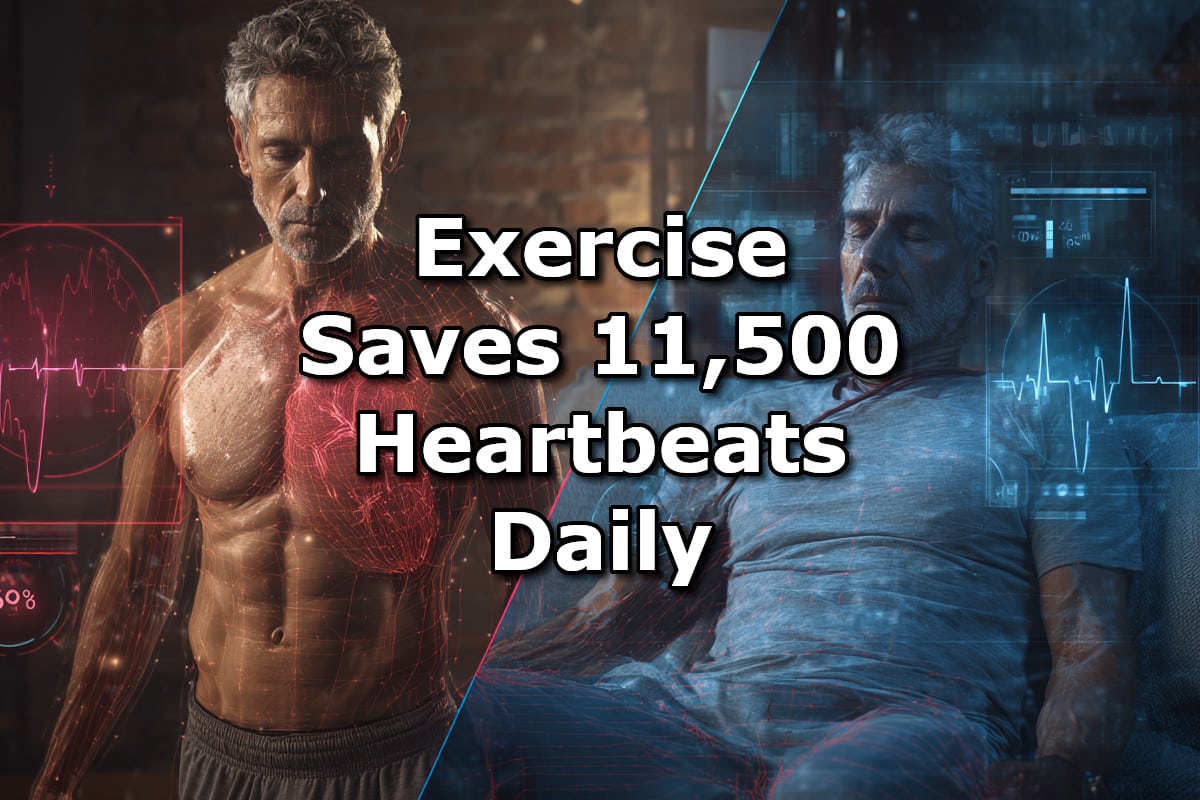You’ve heard it before. Maybe from some wannabe fitness guru or that one uncle who thinks he knows everything about health.
“Don’t exercise too much. You only have so many heartbeats in your lifetime.”
It’s the kind of advice that sounds smart but keeps men over 40 stuck on the couch, getting weaker by the day. And it turns out, it’s complete garbage.
The Heartbeat Myth Just Got Destroyed by Science
A team of Australian researchers from St Vincent’s Institute of Medical Research just published a study in JACC: Advances that completely destroys this myth. Not just questions it. Destroys it.
Professor Andre La Gerche and his team tracked the heart rates of 109 athletes and 38 non-athletes for 24 hours straight. The results weren’t even close.
Athletes averaged 68 beats per minute. Non-athletes hit 76 beats per minute.
Do the math over a full day and you get something incredible. Athletes used 97,920 heartbeats per day. Non-athletes burned through 109,440 heartbeats.
That’s 11,500 fewer heartbeats every single day for the people who exercise regularly.
Your Heart Gets Smarter When You Train It
Here’s what’s actually happening in your body. Having studied human biology, I’ve learned that the heart is a muscle that adapts to demand. When you train consistently, your heart gets stronger and more efficient.
Think of it like upgrading from a gas-guzzling truck to a fuel-efficient sports car. The sports car gets you where you need to go using less fuel. Your trained heart pumps more blood with each beat, so it doesn’t need to beat as often.
The fittest people in the study had resting heart rates as low as 40 beats per minute. Compare that to the average person sitting at 70 to 80 beats per minute.
That’s not just impressive. That’s your body operating like a well-oiled machine instead of a broken-down jalopy.
Sure, your heart rate spikes during exercise. You might hit 140 or 160 beats per minute during a hard workout. But here’s the key: you’re only training for maybe an hour a day.
For the other 23 hours, your trained heart is cruising at a much lower rate. The savings during rest completely wipe out any “extra” beats during exercise.
You actually come out ahead by thousands of beats every single day.
This Matters More After 40 Than You Think
Let’s talk about what this means for men in their 40s, 50s, and beyond. This isn’t just about heartbeats. It’s about staying functional and free.
A lower resting heart rate is one of the strongest predictors of cardiovascular health. It means your heart isn’t constantly stressed. It means you’re not wearing out your cardiovascular system with every step you take.
Regular exercise does more than just save heartbeats. It strengthens your entire cardiovascular system, reduces your risk of heart disease, improves mental health, and is directly linked to longer life spans.
You know what doesn’t do that? Sitting on the couch because you’re worried about “using up” your heartbeats. That’s how you end up weak, sick, and dependent on others in your later years.
I’ve seen too many men who wanted to travel, hike mountains, play with grandkids, but couldn’t because their bodies failed them. Not because they exercised too much. Because they didn’t exercise enough.
The Exception: Don’t Go Full Tour de France
Now, let’s be honest about the limits here. The researchers also looked at professional cyclists racing in the Tour de France. Those guys pushed their daily heartbeat totals way higher than normal people.
Extreme endurance events do temporarily increase your total daily heartbeats.
But here’s what Professor La Gerche said about that: “The biggest bang for your health buck is going from unfit to moderately fit. Just a few hours of purposeful exercise each week can transform your heart’s efficiency.”
You don’t need to become a professional athlete. You don’t need to run marathons every weekend. You need consistent, moderate exercise that challenges your cardiovascular system without destroying it.
What This Means for Your Training
So what should you actually do with this information? Here’s the practical breakdown for men over 40 who want to maximize their health and longevity.
1. Focus on consistency over intensity. Three to five sessions per week of moderate exercise beats one insane workout followed by a week on the couch.
2. Include cardiovascular training. Walking, jogging, cycling, swimming. Pick something that gets your heart rate up for 30 to 60 minutes. This is where you build that cardiac efficiency.
3. Don’t fear the elevated heart rate. When your heart rate jumps during exercise, that’s not damage. That’s adaptation. You’re training your heart to become more efficient.
4. Monitor your resting heart rate. Check it first thing in the morning before you get out of bed. As you get fitter, you should see this number drop. That’s your body becoming more efficient.
5. Mix in strength training. While the study focused on cardiovascular fitness, resistance training builds the muscle and bone density you need to stay functional after 40.
6. Start where you are. If you’re currently sedentary, you don’t need to become an athlete overnight. Even moving from completely inactive to moderately active creates massive benefits.
7. Give it time. Your resting heart rate won’t drop overnight. These adaptations take weeks and months of consistent training. Be patient.
Track Your Progress and Turn It Into a Game
Here’s something that makes all of this more real: get yourself a decent sports watch and actually watch your resting heart rate drop as you get fitter.
I’m serious enough about this that I wear a Garmin Forerunner 965. It tracks everything: heart rate, training load, recovery, sleep quality. Watching those numbers improve over weeks and months? That’s addictive in the best possible way.
You turn fitness into a game you can win.
But you don’t need to drop serious cash to start. Companies like Coros make solid entry-level sports watches that track heart rate and basic metrics. I started out with a Coros Pace, and it was a great starter watch. Pick one with an app that syncs to your phone so you can actually see your progress over time, and get addicted to improving your numbers.
Here’s what you want to track:
Your resting heart rate. Check it first thing every morning. This is your main scorecard. As you get fitter, watch this number gradually drop. That’s proof your cardiovascular system is adapting.
Heart rate during workouts. See how your body responds to different intensities. Over time, you’ll notice it takes more effort to push your heart rate up. That’s your improved fitness showing up in real data.
Recovery metrics. Most decent watches show how well you’re recovering between sessions. This tells you when to push hard and when to back off.
Training consistency. The app shows your workout history. Missing days becomes obvious. Hitting your weekly targets feels like leveling up in a game.
The data turns abstract concepts like “getting fitter” into concrete numbers you can track. And for guys who like to measure progress and optimize systems, this is gold.
You’re not just working out blindly. You’re collecting evidence that your body is getting more efficient, exactly like this study proves.
The Bottom Line
The myth that exercise “uses up” your heartbeats is exactly that. A myth. One that’s kept too many men stuck, weak, and unhealthy.
The science is clear. Regular exercise saves heartbeats. It makes your cardiovascular system more efficient. It extends your life.
Every time you skip a workout because you’re worried about working your heart too hard, you’re actually doing the opposite of what you think. You’re forcing your heart to work harder all day, every day, just to keep you alive.
That’s the real waste of heartbeats.
Get off the couch. Move your body. Train consistently. Your heart will thank you by beating less often and lasting longer.
Want More No-BS Health Science?
This is the kind of straight-shooting health information you need to stay strong and free after 40. No corporate wellness garbage. No Big Pharma solutions. Just real science explained in plain English.
Sign up for the MadMadViking newsletter and get weekly insights on health, fitness, and living free after 40.






